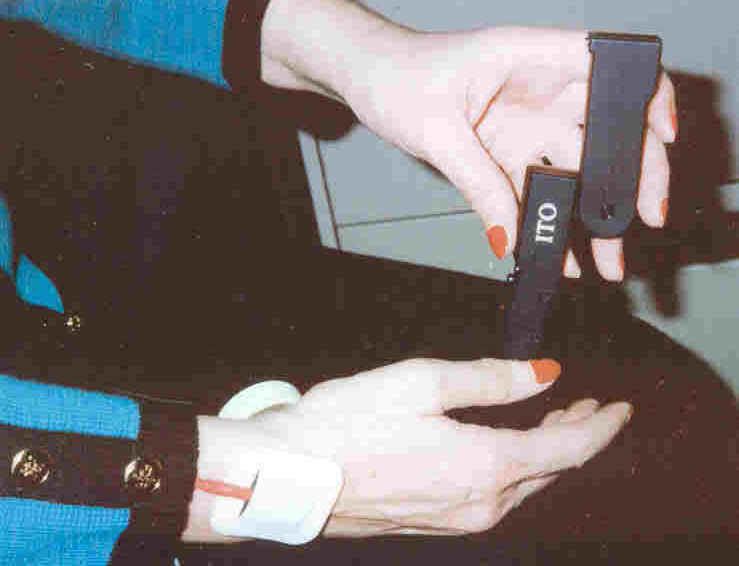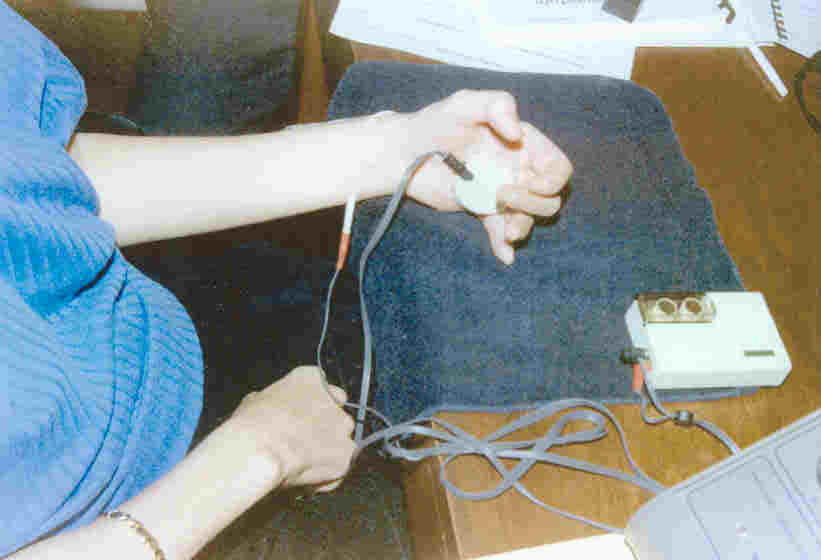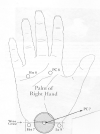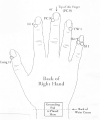| LASER
ACUPUNCTURE FOR CARPAL TUNNEL SYNDROME & HAND SPASTICITY |
|
|
Laurance
Johnston, Ph.D.
|
|

Dr. Margaret Naeser, Ph.D., Lic.Ac., a Boston
University School of Medicine research professor and Department of
Veterans Affairs (VA) investigator, has developed an effective
alternative medicine therapy for carpel tunnel syndrome (CTS) and
spasticity-related hand-flexion problems. Dr. Naeser’s therapy
specifically stimulates hand acupuncture points with a low-energy laser
beam an d a mild electrical current. You can perform this relatively
simple and inexpensive therapy at home with some upfront guidance by a
licensed acupuncturist. d a mild electrical current. You can perform this relatively
simple and inexpensive therapy at home with some upfront guidance by a
licensed acupuncturist.
As a mainstream neuroscientist who is also an
acupuncturist, Dr. Naeser has the cross-disciplinary expertise necessary
to integrate Eastern healing approaches into Western biomedicine, as is
the case with her CTS therapy. Because of her unique viewpoint, at a
policy-setting 1997 Consensus Development Conference, the National
Institutes of Health (NIH) asked her to summarize acupuncture’s use in
treating central nervous system (CNS) paralysis.
Acupuncture:
As noted in Dr.
Naeser’s NIH summary, as well as several other articles posted on this
web site (see “Acupuncture and Physical Disability,”
“Acupuncture
& Spinal Cord Injury (SCI) – Summary of Key Studies,” and
“Laserpuncture for SCI”), acupuncture has considerable potential to
treat health problems associated with spinal cord dysfunction (SCD),
including improvement in spasticity, bladder and bowel control, and, in
some cases, restoration of function.
Acupuncture’s philosophy believes that a
life-force energy called qi (pronounced chee) permeates all living
things through channels called meridians. These meridians are
periodically punctuated by acupuncture points, which, under traditional
theory, represent small skin areas that are energy vortexes, and, using
modern scientific measurements, correspond to areas of greatly reduced
electrical resistance. Stimulating these points through traditional
needle insertion, heat, or pressure, or through contemporary
energy-emitting devices promotes healthy energy flow. Because most
meridians either originate or terminate at finger or toe tips, hand and
foot disorders seem especially amenable to acupuncture.
Although acupuncture was developed without the
benefit of modern physiological and anatomical insights, scientists are
now explaining the ancient discipline through mechanisms involving the
stimulation of neural pathways, neurotransmitters, and key energy
metabolites.
Laser Therapy:
Naeser’s acupuncture therapy uses a laser pointer
powered by two AAA batteries. It emits a red light beam somewhat similar
to a grocery-store checkout scanner and poses no risk unless you stare
directly at the beam.
Lasers amplify light by producing coherent,
single-frequency beams and are characterized by power and wavelength. Their power can vary greatly. For example, 100-watt
surgical cutting lasers have 20,000-fold greater power than the
5-milliwatt laser pointer used in Dr. Naeser’s program. Because light
travels in waves, wavelength refers to the distance measured in
nanometers (one-billionth of a 39.4-inch meter) between consecutive wave
peaks. The laser pointer used in Naeser’s program emits a
670-nanometer wavelength, corresponding to a red beam of light.
Because low-level lasers represent a noninvasive, painless mechanism for biostimulation, their
potential therapeutic applications - including SCD - have grown greatly
over time, especially in other countries.
When lasers are directed toward acupuncture points, the therapy
becomes laser acupuncture.
In spite of the innocuous nature of these
low-energy lasers, the Food and Drug Administration (FDA) and state
regulations are ambiguous and inconsistent. As such, the availability of
laser acupuncture may vary considerably depending upon where you live.
Electrical Stimulation:
Dr. Naeser’s therapy also employs a
procedure called microamps transcutaneous electrical nerve
stimulation (TENS) using a MicroStim 100 TENS device. In spite of
its intimidating-sound, TENS represents a strait-forward procedure, in
which mild electric currents are applied to specific skin areas by two
circular electrodes connected to a shirt-pocket-size power pack (see
photos). TENS devices have a long history of safe use for treating
localized pain (but don’t use them with pacemaker).
Carpal Tunnel Syndrome:
CTS is a painful hand condition created through
compression of the median nerve as it passes through the carpal tunnel
from the forearm to the palm. It is aggravated by repetitive motion,
including pushing a wheelchair. Studies indicate that 30 – 73% of
manual wheelchair users will experience CTS.
Conventional CTS treatments include simple hand
splinting; steroid injection into the carpel tunnel, which has marginal
long-term efficacy; and, surgical release of the impinging ligament.
Although CTS does not generate the visibility of
life-threatening disorders, its impact on national health-care and
worker productivity is immense. For example, surgery is performed in
approximately 40-45% of CTS cases, with estimates of more than 460,000
procedures performed each year, and a direct medical cost of over $1.9
billion.
More than half of all workers afflicted with CTS
miss over 30 days of work. Clearly, these statistics warrant the
consideration of less expensive, less invasive, and more effective
therapeutic alternatives for CTS, such as Dr. Naeser’s therapy.
Unlike many alternative, as well as mainstream,
therapies, Dr. Naeser’s approach is supported by substantial
scientific evidence, including rigorously designed clinical studies.
These studies indicate that approximately 90% of individuals with
mild-moderate CTS treated with her program three times a week for 4-5
weeks by a licensed acupuncturist will have significant, enduring relief
from CTS pain.
Dr. Naeser believes that these beneficial effects
may be mediated through a number of mechanisms, including augmented
production of a key energy metabolite called ATP; increased
levels of the neurotransmitter serotonin, decreased inflammation,
and improved local blood circulation.
Although Dr. Naeser’s research has focused on
CTS, extensive anecdotal observations indicate that the therapy helps
spasticity-related hand-flexion difficulties, such as the fisted or
clawed hand (see photo), associated with a variety of CNS disorders.
After treatment, the hand relaxes, the fingers can open up more, and  existing dexterity may improve. In addition, Naeser’s therapy appears
to help those who have cramping and spasticity problems in leg and foot
muscles.
existing dexterity may improve. In addition, Naeser’s therapy appears
to help those who have cramping and spasticity problems in leg and foot
muscles.
Procedure:
Naeser’s
straightforward therapy can be readily carried out at home after an
acupuncturist has guided you through it, showing you the specific
location of the relatively small acupuncture points that are to be
targeted by the laser. Procedural details are discussed in the attached
protocol. Readers interested in the therapy should share
the protocol with a licensed acupuncturist. (The American Association of
Oriental Medicine (610-266-1433) can help you to locate a licensed
acupuncturist trained in laser acupuncture.)
When treating
CTS, the MicroStim 100 TENS device’s blinking red-light circular lead
el ectrode is attached through a sticky patch to the center of the wrist
crease, and the grounding pad attached to the opposite side of the
wrist. The laser pointer is then directed to fingertip and hand
acupuncture points (see figures and photo). Because a key acupuncture p ectrode is attached through a sticky patch to the center of the wrist
crease, and the grounding pad attached to the opposite side of the
wrist. The laser pointer is then directed to fingertip and hand
acupuncture points (see figures and photo). Because a key acupuncture p oint is located on the wrist crease, this point is stimulated with
the
laser before electrode attachment. The 45-minute procedure should be
repeated every other day for five weeks. oint is located on the wrist crease, this point is stimulated with
the
laser before electrode attachment. The 45-minute procedure should be
repeated every other day for five weeks.
In the case of
hand spasticity and flexion problems, the TENS lead electrode is
attached to an acupuncture point in the palm (see photo) and the
grounding pad placed over a point an inch or so above the wrist (see
attached protocol for procedural details). Laser stimulation is
essentially the same.
Conclusion:
This
laser-acupuncture therapy is a scientifically proven, highly effective
treatment for CTS and may also have considerable potential for treating
spasticity-related, hand-flexion difficulties. However, because the
therapy’s concepts of energy medicine are only beginning to be
integrated into mainstream medicine, most conventionally trained
physicians will have little appreciation of the therapy’s potential,
and you will, to a large degree, have to educate yourself on this
relatively simple therapy.
Adapted From article appearing Paraplegia News,
November 2001 (For subscriptions, contact www.pn-magazine.com).
REFERENCES
| Cooper, R.
and Bonninger, M.L., Walking on your Hands, Paraplegia News,
March 1999, pp. 12-16. |
| Liu, S.,
Laser Acupuncture Primer, California Journal of Oriental
Medicine, Vol. 12, No. 1, Winter 2001, pp.23-29. |
| Liu, S.,
Treatment of Carpal Tunnel Syndrome with Laser Acupuncture, California
Journal of Oriental Medicine, Vol. 12, No. 3. Summer 2001, pp.
16-17. |
| Naeser,
M.A., “Acupuncture in the Treatment of Paralysis Due to Central
Nervous System Damage,” J.
Alternative and Complementary Medicine, Vol. 2, 1996, pp.
211-248. |
| Naeser, M.
and Deuel, S.K., “Review of Second Congress, World Association
for Laser Therapy Meeting (WALT), J.
Alternative and Complementary Medicine, Vol. 5, Number 2,
1999, pp.177-188. |
| Branco, K.
and Naeser, M. A., Carpal Tunnel Syndrome: Clinical Outcome After
Low-Level Laser Acupuncture, Microamps Transcutaneous Electrical
Nerve Stimulation, and Other Alternative Therapies-An Open
Protocol Study,” J. Alternative and Complementary Medicine,
Vol. 5, Number 1, 1999, pp. 5-26. |
| Naeser,
M.A., Hahn, K.K., Lieberman, B.E., and Branco, K.F., “Carpal
Tunnel Syndrome Pain Treated with Low-Level Laser and Microamps
TENS, Controlled Study,” Archives of Physical Medicine &
Rehabilitation, 2001, in press. |
| Naeser,
M.A., Alexander, M.P., Stiassney-Elder, D., Galler, V., Hobbs, J.,
Bachman, D., and Lannin, L.N., “Laser Acupuncture in the
Treatment of Paralysis in Stroke Patients: A CT Scan lesion Site
Study,” American J. of Acupuncture, Vol. 23, Number 1,
1995, pp. 13 – 28. |
| Naeser,
M.A., and Wei, X.B., “Laser Acupuncture – An Introductory
Textbook for Treatment of Pain, Paralysis, Spasticity and other
Disorders, Boston Chinese Medicine, 1994. |
| Naeser,
M.A., Hahn, C.K., and Lieberman, B.E., “Naeser Laser Home
Treatment Program for the Hand – An Alternative Treatment for
Carpal Tunnel Syndrome and Repititive Strain Injury,” American
Association of Oriental Medicine, 1997. |
| Naeser,
M.A., “Laser Acupuncture for Carpal Tunnel Syndrome,” see www.acupuncture.com.
(click on acupuncture and then carpal tunnel syndrome) |
TOP |
|
|
|
|
|
|
|
|
|
|